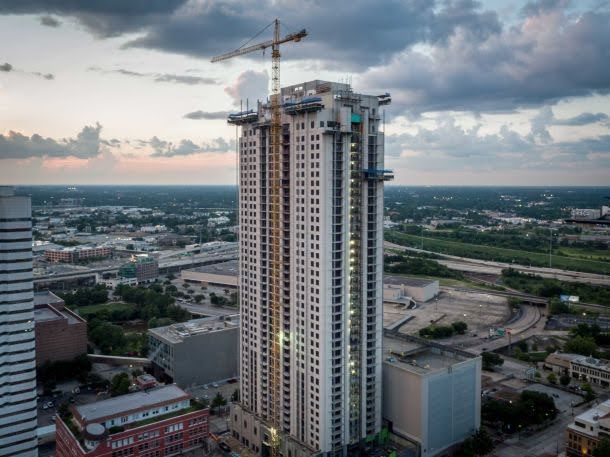The Role of Lightweight Concrete in High-Rise Construction

January 16, 2025
High-rise buildings are the defining feature of modern skylines. As cities grow upward, architects and engineers constantly seek innovative materials to make taller, safer, and more efficient structures. Lightweight concrete (LWC) is one such revolutionary material, offering significant advantages for high-rise construction. Let’s explore the role Lightweight Concrete (LWC) plays in shaping the urban landscape and why it’s becoming a favorite choice for builders worldwide.
Benefits of Lightweight Concrete in High-Rise Construction
1. Reduced Dead Weight
One of the most significant advantages of Lightweight Concrete (LWC) is its lower density. By reducing the dead weight of a structure, Lightweight Concrete (LWC) minimizes the load on foundations, enabling the construction of taller buildings without requiring extensive foundational reinforcement. This weight reduction also helps lower material costs and transportation expenses.
2. Faster Construction
Lightweight Concrete (LWC)’s lightweight properties and use of expanding agents streamline the construction process. Workers can handle and install components more efficiently, leading to shorter project timelines and reduced labor costs. This makes it particularly beneficial in high-rise projects where speed and precision are crucial.
3. Energy Efficiency
Lightweight Concrete (LWC) boasts excellent thermal insulation properties. By reducing heat transfer, it helps maintain comfortable indoor temperatures, lowering energy consumption for heating and cooling. This energy efficiency aligns with the growing demand for sustainable building practices.
4. Fire Resistance
Safety is paramount in high-rise construction, and Lightweight Concrete (LWC) delivers it. Its non-combustible nature enhances a building’s fire resistance, providing an additional layer of safety. For instance, foam concrete with a 150 mm thickness can resist fire for up to four hours, making it a reliable choice for critical structural elements.
5. Sound Insulation
Urban environments can be noisy, and sound insulation is a key consideration for high-rise living. The air voids in Lightweight Concrete (LWC) effectively dampen sound waves, reducing noise transmission between floors and improving the quality of life for residents.
Applications of Lightweight Concrete in Construction
1. Structural Elements
Lightweight Concrete (LWC) is commonly used in load-bearing elements such as beams, columns, and slabs. Its strength and reduced weight make it an excellent choice for high-rise structures that require durability and stability.
2. Flooring
Lightweight Concrete (LWC) is widely used for flooring in multi-story residential and commercial buildings. It’s strong enough to handle daily use while being lightweight and easy to install, reducing the overall project timeline.
3. Precast Elements
Lightweight Concrete (LWC) is perfect for precast elements like wall panels, facade components, and architectural ornaments. These components can be manufactured off-site and quickly installed, reducing construction time and ensuring precision.
4. Infrastructure Projects
Beyond buildings, Lightweight Concrete (LWC) finds applications in bridges, tunnels, and sound barrier walls. Its lightweight and durable properties help reduce strain on structures while ensuring long-term performance.
5. Geological Applications
Lightweight Concrete (LWC) is also used for soil stabilization and void filling in construction projects. Its ability to provide strength with minimal weight makes it invaluable for challenging geological conditions.
6. Aesthetic Flexibility
Lightweight Concrete (LWC) can be molded into various shapes and forms, making it a preferred choice for intricate architectural designs in high-rise gated communities. Its adaptability enables designers to create unique facades and decorative elements that enhance the visual appeal of buildings.
7. Eco-Friendliness
Lightweight Concrete (LWC) is an environmentally friendly option for high-rise gated communities. Its production process uses less natural aggregate and energy, reducing the overall carbon footprint. Additionally, its energy-efficient properties contribute to long-term environmental sustainability.
Why Choose Lightweight Concrete for High-Rises?
In a world where urbanization is accelerating, materials that combine efficiency, sustainability, and performance are essential. Lightweight Concrete (LWC) offers all these benefits and more:
- Cost Savings: Reduced material, labor, and transportation costs.
- Environmental Benefits: Lower energy consumption and sustainable production practices.
- Versatility: Suitable for a wide range of applications in construction and infrastructure.
Choose EcholonCrete by Aparna RMC
For those seeking a top-tier lightweight concrete solution, EcholonCrete Concrete by Aparna RMC, backed by Aparna Enterprises Limited stands out as a trusted choice. Designed for efficiency and sustainability, EcholonCrete Concrete delivers exceptional performance in high-rise construction, providing enhanced durability, thermal insulation, and fire resistance. Its innovative composition ensures long-lasting and cost-effective results, making it a preferred option for modern builders.
